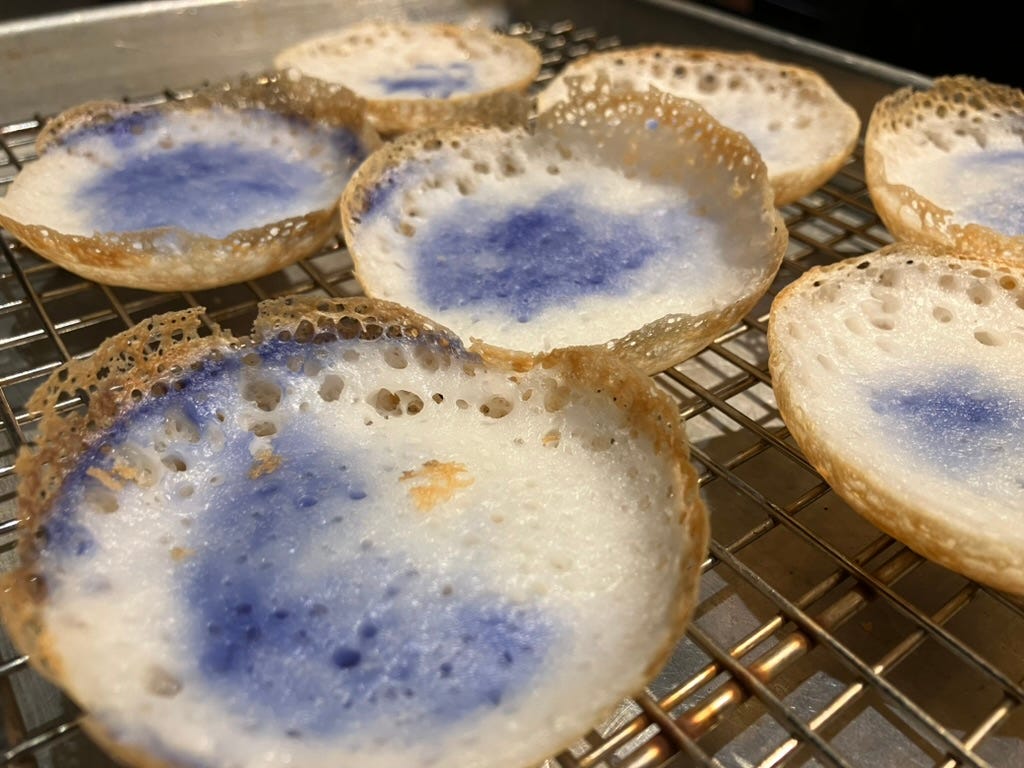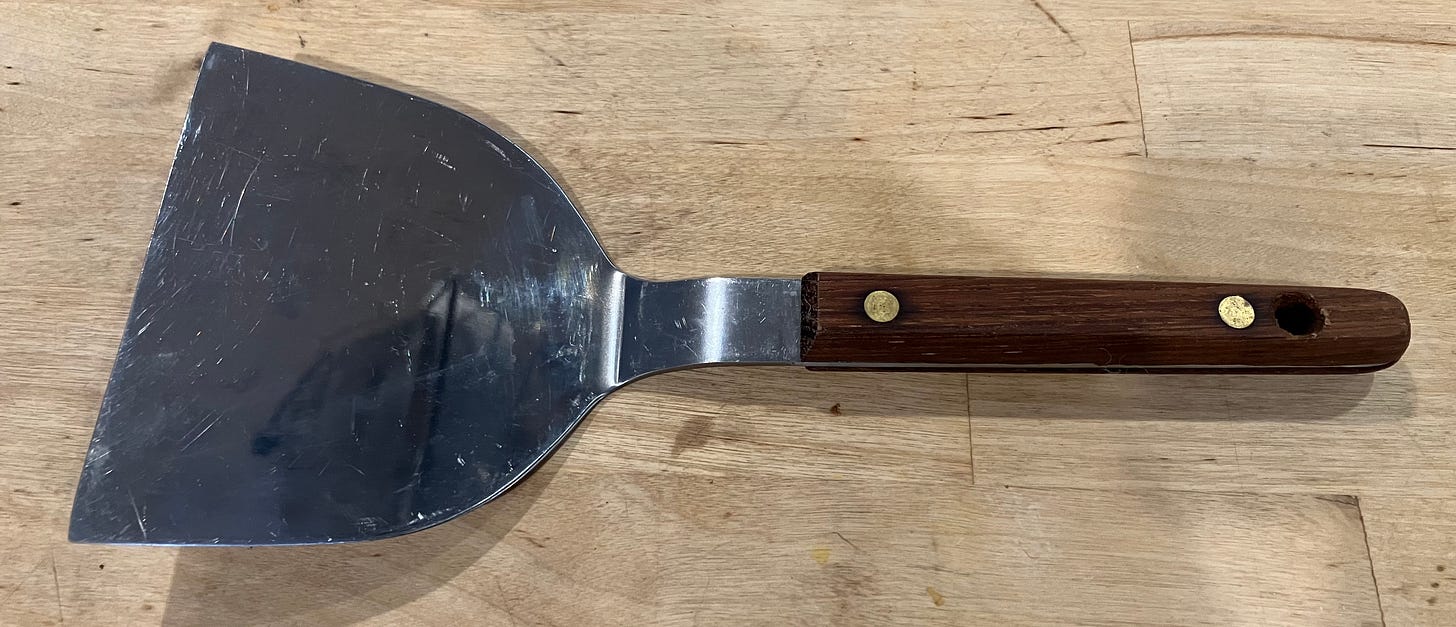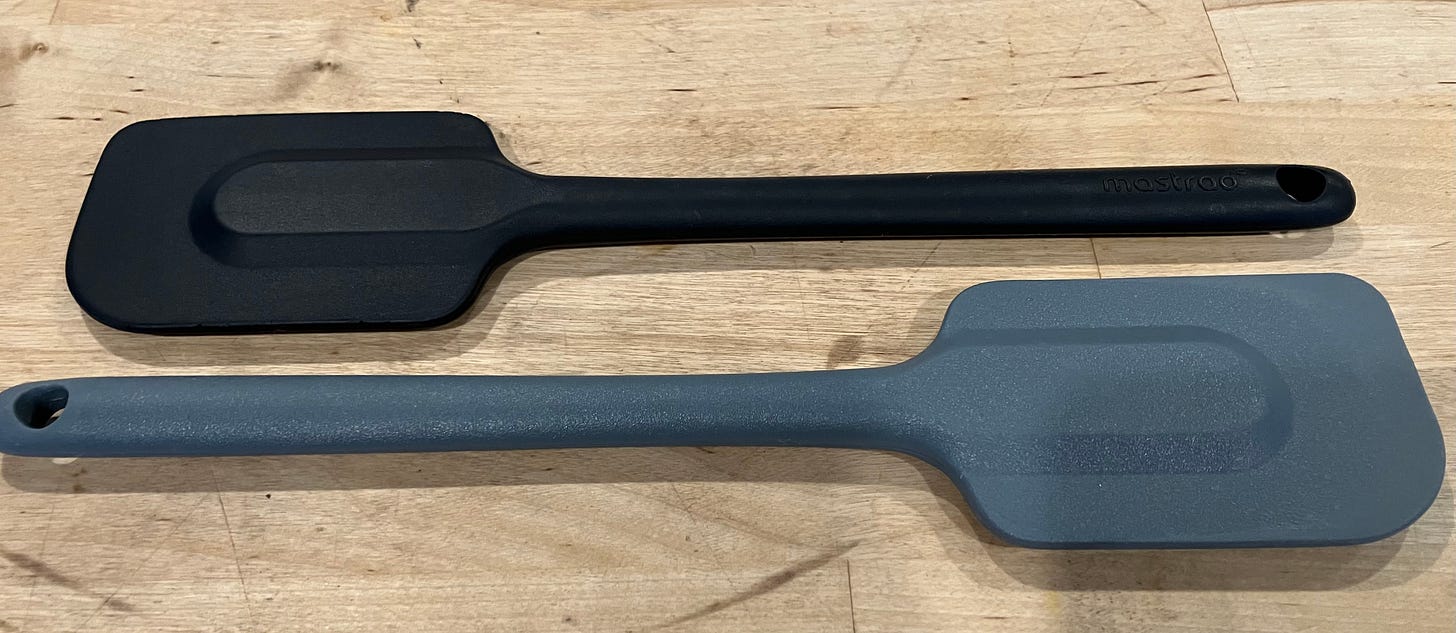This Sunday, at Backbar, I’m making mee siam, which might be the most underrated one dish meal in Singapore, a simple yet gorgeously intricate summa of every culinary influence between the hills of Yunnan and the Malacca Strait. It’s deep, exuberant, light in body, but laden with warmth and sneakily rich. The one issue with mee siam is that it’s bantamweight, almost more a snack than a meal – the solution is a second plate.
I’ll also have appam-shaped apom for dessert, and a couple other wild ideas.
Just look at those frills. These are fairly small, about 6cm across, the cookie rack beneath them gives a sense of scale.
Presumably, you’re reading this because I don’t generally write recipes, pitch ingredients, or tell you what fabulous new products to buy. So perhaps writing about my favorite spatulas will help me set a new record for unsubscriptions, dislikes, and whatever other signs of reproof substack can offer. We all have our ambitions.
Spoons are a matter of serendipity. You find yours, or they find you. There’s an infinite variety of spoons, but there’s also less to differentiate between them. Even a shallow, bendy, ill-made bit of stamped aluminum will do the job, unless the job is making a one-spoon quenelle, and if you’re making those, you’ve definitely found at least one spoon already.
But spatulas are tools of a trade, and spoons are personal belongings, so there are fewer models of spatula, and they’re made with more attention to function, which creates more opportunity for dysfunction. They can frustrate in a way spoons rarely do, and at the same time, the frustrations are foreseeable and avoidable, so choosing a spatula is, or should be, a matter of deliberation.
Here are my three favorites.
1.
Knives aside, I can’t think of a kitchen tool that gives me greater pleasure than the Eatco/Yoshikawa Tolu/Toru flexible spatula.
Nimble, architectural, and transparent, it’s almost entirely replaced my old warhorse, the standard 6” Ateco palette knife:
The Ateco was my primary cooking tool after I got comfortable on the line (which was about 2 years after we opened our first restaurant). The round tip has its uses, but the Toru matches it for nimbleness. The Toru is fractionally more rigid. Allied to its angularity, this lets me cut a frittata or latke at the table. And I tolerated but never loved the handle on the Ateco, even after the modification you see in the photo. Something about it felt disproportionate and unnecessary. There was a little too much of it, just as there’s a little too much shoulder on the blade. Compare that to the Toru’s spareness, that little hook that embraces the muscle on the back of your hand. Maybe it’s an illusion that holding the Toru’s naked steel gives me more feedback, but if so, it’s a convincing one.
2.
When I want something a little more resolute, as when I’m turning a whole lamb shoulder, I use a teppanyaki spatula.
It’s such a joy to use on pancakes or eggs. The Toru and Ateco will do those too, but they’re elegant enough to feel studied, while the teppanyaki spatula is, in the most delightful way, a toy. It makes flipping pancakes feel like play. This one is perhaps overlarge at 105mm wide, and wants the broad pampa of a griddle or your largest sauteuse, but you can get them in different sizes, and if you want, in bare steel.
3.
My first two recommendations are perhaps idiosyncratic, but this third one is simply the best silicone spatula ever made, the Mastrad all silicone.
Just stiff enough to replace a wooden spoon, just fine enough to clean the bottom of a pot (the broad, flat end is key) and wholly coated so the head will never fall off. You want a metal spatula that feels like a knife in water, one that creates an invisible separation between pan and food. Silicone spatulas work best when they feel like the big, sloppy tongue of an enthusiastic German shepherd. You want to feel them dragging across the surface, sticking all the way. These have that quality. The slim handles look unwelcoming, but having tried many different attempts at ergonomics, I’ve come to appreciate their neutrality. The black one has been in daily use for over a decade.
April’s also been a delightfully fertile month for food writing. Three things to read:
Michael Nagrant wrote a 10,000 word paean to la grand cuisine, and a cook I’d never heard of. It’s a fado of dumbwaiters and butter florets and carved bell peppers and people who’ve been doing this for decades. Maybe M. Liccioni would like to retire to Singapore and run a hawker stall. It’s warmer than Chicago, and I think he’d feel right at home.
Kate Ray on cooking without recipes:
Could we say that every meal cooked is a singular act of creativity and a recipe its imperfect record? Is this obnoxious, and does saying it elevate the act of cooking beyond its essential role of nourishment? But why isn’t nourishment and every other mundane repetitive task also an act of creativity?
A media imbroglio, which has probably gone viral, but there’s also significant overlap between the folks who think “going viral” means feeling cruddy, and the folks who still treat the New York Times as the oracle it used to be.









Nothing beats a nice hot bowl of mee siam from the local hawker centre early in the morning.
I have always loved a Matfer maryse. I was quite particular and would mourn them when they finally got burnt or the handle snapped.
I seem to have discovered all sorts of things to be pedantic about over my career.